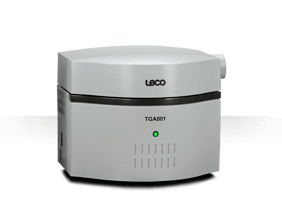 The thermogravimetric analyses of the TGA801 and its predecessors can do more than measure organic materials. With its ability to handle large, gram-sized samples, the TGA801 has become an invaluable tool for the monitoring of industrial byproducts, such as flue-gas desulfurization (FGD) solids.
The thermogravimetric analyses of the TGA801 and its predecessors can do more than measure organic materials. With its ability to handle large, gram-sized samples, the TGA801 has become an invaluable tool for the monitoring of industrial byproducts, such as flue-gas desulfurization (FGD) solids.
FGD systems, such as limestone forced oxidation scrubbers (LSFO) are used to oxidize sulfur dioxide from flue gases before they pass through absorbers removing contaminants from industrial emissions. This minimizes scaling problems in the absorbers, increasing their lifespans and availability. The scrubbers have the added benefits of creating solid byproducts that can be sold for their own uses. LSFOs, which are the preferred wet FGD technology processes, use forced oxidation to remove up to 95% of SO2 and precipitate it as CaSO4•2H2O, or gypsum. The gypsum can then be sold to various industries such as wallboard manufacturers, cement manufacturers, or for agricultural purposes. Even the worst-quality gypsum can be land-filled, which is easier to handle than the original sulfur dioxide.
 Just where that gypsum can be sold depends on the quality of the gypsum. Wallboard-grade gypsum, for example, requires the solids to be 96% gypsum. Measuring this makeup accurately is therefore a vital step of the production. A macro thermogravimetric analyzer (TGA) like LECO's TGA801 can measure samples of a full gram, which allows for less sample preparation and greater accuracy than from micro TGAs, which can only handle sample sizes up to 50 mg. The TGA801 can also handle up to 19 samples simultaneously, allowing for huge productivity boosts in a laboratory measuring sample quality.
Just where that gypsum can be sold depends on the quality of the gypsum. Wallboard-grade gypsum, for example, requires the solids to be 96% gypsum. Measuring this makeup accurately is therefore a vital step of the production. A macro thermogravimetric analyzer (TGA) like LECO's TGA801 can measure samples of a full gram, which allows for less sample preparation and greater accuracy than from micro TGAs, which can only handle sample sizes up to 50 mg. The TGA801 can also handle up to 19 samples simultaneously, allowing for huge productivity boosts in a laboratory measuring sample quality.
The accuracy and precision of the TGA family for measuring these sorts of FGD solids has been lab-tested time and again over the years. In a 2017 analysis published by ASTM, LECO's experts joined with Western Kentucky University to demonstrate the effectiveness of the TGA701, the predecessor of the TGA801, and its ability to characterize the FGD solids produced by LSFOs. To read the analysis, request a free copy from us. For more information, check out our application note on FGD solids or our FGD poster.


